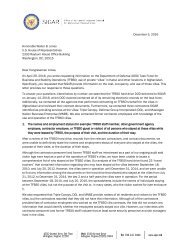SIGAR
2016-04-30qr
2016-04-30qr
You also want an ePaper? Increase the reach of your titles
YUMPU automatically turns print PDFs into web optimized ePapers that Google loves.
Security: The eroding bedrock<br />
Afghan soldiers patrol in wintry countryside.<br />
(CJTF 101 photo by SGT Cooper Cash)<br />
disproportionately higher number of casualties than the ANA due to inadequate<br />
training and equipment, poor planning processes, and a suboptimal<br />
force posture that leaves ANP forces vulnerable at static checkpoints.” 20<br />
Other vulnerabilities fester within the ranks: in late February, Afghan military<br />
personnel detained and disarmed 30 police officers suspected of having<br />
links to the Taliban. Those arrested included the acting police chief of the<br />
Sangin district in Helmand Province. 21<br />
Corruption—an issue where Afghanistan has long stood near the bottom<br />
of global rankings—is another threat to ANDSF effectiveness. As DOD has<br />
reported, “Corruption affects . . . the effectiveness of the MOD [Ministry<br />
of Defense] to support the ANA corps, AAF [Afghan Air Force], and other<br />
force components, [and] counter-corruption efforts are essential to maintaining<br />
international donor support.” For that reason, DOD says, increasing<br />
Afghan ministry accountability “remains a critical part” of the RS mission. 22<br />
Afghan police are also involved. The UN Office on Drugs and Crime has<br />
reported that 42% of Afghans surveyed had paid a bribe to a police officer,<br />
that the average bribe paid to an ANP officer was over $100, and that more<br />
than 50% of ANP officers surveyed thought asking for bribes or procuring<br />
goods or services based on family ties or friendship was usually or sometimes<br />
acceptable. 23<br />
Meanwhile, challenges for security forces are multiplying. Not only did<br />
the Taliban step up attacks during the past winter—usually a relatively quiet<br />
season—but other groups expanded their presence in Afghanistan. They<br />
include al-Qaeda in the Indian Subcontinent—a relatively new offshoot of<br />
al-Qaeda that operates primarily in Afghanistan, Pakistan, and India—and<br />
the Islamic State of Iraq and the Levant-Khorasan Province. 24 Even if these<br />
factions are competing within the same pool of potential recruits that the<br />
Taliban draw upon, their higher profiles can pose additional credibility<br />
challenges for the Kabul government and complicate attempts at political<br />
reconciliation and peace negotiations.<br />
<strong>SIGAR</strong> has had direct experience with the worsening security situation.<br />
When <strong>SIGAR</strong> began staffing its office at the Embassy in Kabul in 2009, its<br />
personnel could access many areas of the city and the countryside; drive<br />
themselves in Kabul, Herat, and Mazar-e Sharif; meet Afghans in their<br />
workplaces; and take ground transportation between the airport and the<br />
Embassy. Now, <strong>SIGAR</strong> and other oversight personnel are largely restricted<br />
to the Kabul embassy compound and the few remaining Coalition military<br />
bases, and for the past year have had to take helicopters to and from the<br />
Kabul airport because of the growing security risk.<br />
The security threat has made it increasingly difficult for many U.S. and<br />
even some Afghan officials to get out to manage and inspect U.S.-funded<br />
reconstruction projects. <strong>SIGAR</strong>, the largest U.S. oversight organization in<br />
Afghanistan, has managed to continue its work of overseeing U.S. programs<br />
and projects, partly through the creative use of local Afghan staff, building<br />
6<br />
Special inspector general I Afghanistan reconstruction




